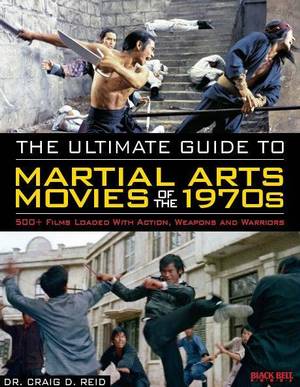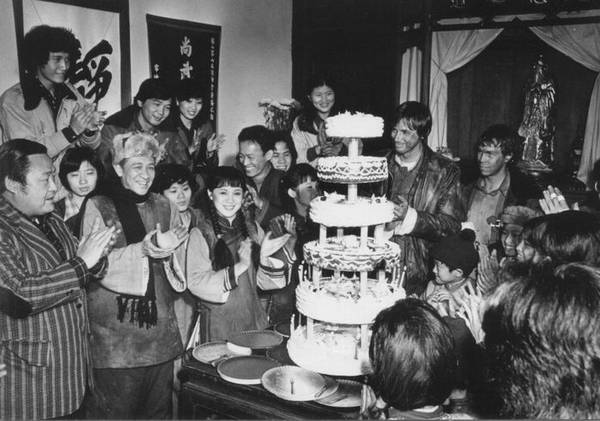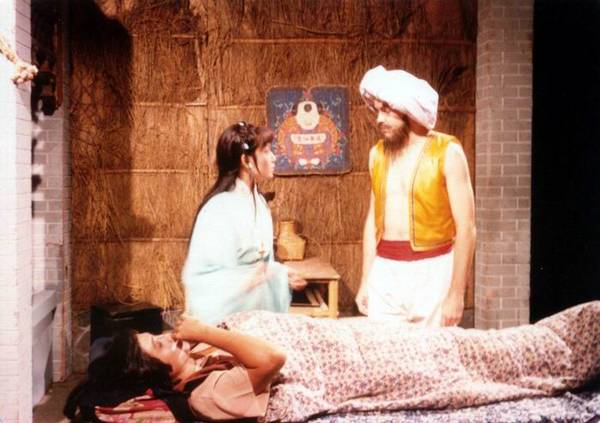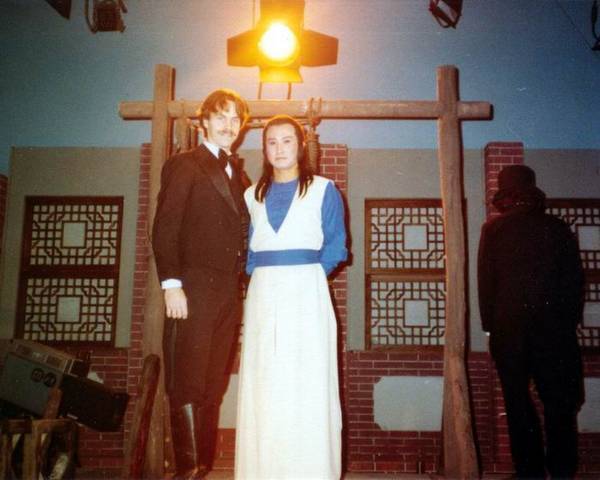 |
Statistics :
11630 Movies
19215 People
1448 Studios
29 Articles
73 Interviews
12 DVD Reviews
32452 Screenshots
3722 Videos
|
|
 |
 |
Ultimate Guide to Martial Arts Movies of the 1970s by Craig Reid |
1/1 - Page 13 |
 |
 |
 |
 |
 |
|

|
The Ultimate Guide to Martial Arts Movies of the 1970s: 500+ Films Loaded With Action, Weapons and Warriors |
by Dr. Craig D. Reid
Published by Black Belt Books
ISBN-10: 0897501926 -- ISBN-13: 978-0897501927
November 2010, US, $26.95, £15.29,
euros19.42, Paperback, 287 pages, glossy paper, color pictures |
| |
|
1- Book content |
- Dedication, acknowledgments, preface, foreword, about the author (8 pages)
- Introduction (5 pages)
- Key to martialogies (5 pages)
- Martialogies from A to Z (226 pages)
- The best 20 martial arts film of the 1970s before and after the book was written (1 page)
- Index of talent aliases (11 pages)
- Complete martial arts film reference list by country: 1970 – 1979 (27 pages) |
| |
| 2- About the Author |
Dr. Craig D. Reid is one of America’s most respected martial arts film historians and critics. In 1979, he became the first regular Caucasian and American stuntman in Chinese kung fu movies and kung fu TV soap operas in Taiwan. Since then, he has accrued credits as a screenwriter, fight choreographer, kung fu scholar, television personality, and university and guest martial arts lecturer.
Dr. Reid started collecting martial arts movies in 1975 (at 19) on Betamax and he now owns about 5000 such films.
Dr. Reid has published more than 1,000 articles, more than half related to martial arts and appearing in magazines such as Black Belt, The Hollywood Reporter, Cinefantastique, Impact, etc. In 1993, one of Dr. Reid’s articles published in Film Quarterly was the first scholarly approach to analyzing Hong Kong action fight choreography published in any academic film journal. |
| |
| 3- About the book |
 The Ultimate Guide to Martial Arts Movies of the 1970s dives deep into the decade that brought martial arts cinema to the masses. This dynamic guide launches into “martialogies” of 500-plus films, including such classics as The Five Venoms, The Big Boss, Drunken Master, Enter the Dragon, Heroes of the East, and the Lone Wolf and Cub series. The Ultimate Guide to Martial Arts Movies of the 1970s dives deep into the decade that brought martial arts cinema to the masses. This dynamic guide launches into “martialogies” of 500-plus films, including such classics as The Five Venoms, The Big Boss, Drunken Master, Enter the Dragon, Heroes of the East, and the Lone Wolf and Cub series.
Each martialogy is filled with humor and contains a concise plot summary, behind-the-scenes reel and real history, fight statistics, insights into martial arts choreography and style, and other surprising factoids about each title.
The second part of the book is a complete index that lists more than 2,000 actors and movies by all their English variations. It also includes an index for movies by country of origin. (Provided by the publisher)
While working on the book, Dr. Reid watched five or six films a day, wrote and researched 15 hours a day, five to six days a week. Now, that’s dedication and passion.
What’s more, Dr. Reid speaks fluent Chinese Mandarin, was a stuntman in kung fu films and lived in Taiwan for a while. There, he experienced first hand the Chinese film and TV industries and the stuntman world.
It's no wonder he has extensive knowledge regarding martial arts, the history, the religion and the culture of Greater China.
All his passion, energy, expertise was put into his book. He has a deep understanding of the subject and he applied a methodical and scientific approach to writing his book
--he is a scientist after all. His 500+ film entries are not mere reviews.
Dr. Reid is more than qualified to propose what he calls ‘martialogy’ on
each film. Martialogy is a term he coined and that means “dissection of anatomical components of a movie: plot, actors, fight choreography secrets, tidbits, info, discussions between the reel and the real stories, characters and martial arts styles.” The entries or martialogies (generally half a page per film) also feature fight statistics, numbers of training and fighting sequences, and their length, as well as the
martial arts content percentage for each films.
The 500+ 1970s martial arts films reviewed are mostly from Hong Kong, Taiwan, Japan, USA, and India, with an emphasis on Chinese language kung fu films (354 entries/500). Most of them being from the Shaw Brothers. Beautiful stills from the films illustrating the book are mostly provided by Celestial Pictures Ltd., the company that owns the rights to the Shaw Brothers catalogue.
Dr. Reid is thorough on many levels and his prose is clear, entertaining,
witty and engaging.
What we liked about the book:
-Great insights: Behind the scene factoids and cultural, historical and religious references.
-The book with color images and glossy paper is as precious as a coffee-table book (minus the hardback).
-The obvious passion and expertise behind each line.
-Riddles in some entries to make the reader
search for other films in the book with the same references, actors or themes.
-The way the author tackles each film entries, with hard data, plot summary and behind-the-scene info is pertinent. He offers a valuable resource, one that won’t be obsolete in 10-15 years.
What we regret:
-This is a mixture of martial arts films from countries with different cultures and different approaches to the action film genre (Hong Kong and its wuxiapian, Japan and its yakuza/samurai films and India and its action films). That said, the book is on
worldwide martial arts movies of the 1970s, but there are so many entries for Chinese films, that when an entry for a film from another country pops out it feels a
bit out of place.
-A lot of excellent Hong Kong classic kung fu films of the 1970s are missing (Hapkido).
-There is no index with the film entries + page number for a quick search.
This reviewer especially liked:
-The author’s introduction to his life events that brought him to write this book. Extremely interesting. Dr. Reid’s life deserves a book in itself (see how he dubbed Chinese films in the book and our interview below).
-The fabulous entries for The Iron Fisted Monk, Enter The Dragon, Lady Whirlwind and The 36th Chamber of Shaolin.
-How Dr. Reid analyzes the kung fu moves and action choreographies.
|
| |
| 4- In Short |
| This is one of a kind: a beautiful book about a beautiful cinema genre (mostly) from Asia. Behind the scene factoids and cultural and historical references alone make the purchase compulsory. Fans of martial arts films cannot miss out on such informed tome, especially considering its fair price.
The book is available from the Black Belt website in the USA and also from the Amazon websites (from the USA, the UK and Europe). |
| |
| 5-
Interview with the author |
| As we had a few questions regarding Dr. Reid's methodology and what he included and excluded from his book, we sent him an email. |
| |
| -- Introduction |
 HKCinemagic: Can you elaborate on your work in the TV/film industry in Taiwan? What did you do exactly and did you participate in well-known films? HKCinemagic: Can you elaborate on your work in the TV/film industry in Taiwan? What did you do exactly and did you participate in well-known films? |
Dr. Craig D. Reid: My first big film was The Flying Tigers and the Kung Fu Kids (1981, by Ding Shan-xi aka Ding Sin Saai, starring Chia Ling aka Judy Lee). I was supposed to just be one of the main actors and of course expected to do all of my own stunts and fights. At the time I had a background in Okinawan Goju Ryu, Wing Chun, Boxing, Jeet Kun Do (as it seems we all said that back then due to our wanting to emulate Bruce Lee’s freedom from the classical mess) and some kendo. It was an anti-Japanese film about how 12 kids break my partner and I (we were captured Flying Tigers pilots) out of a Japanese POW camp. I quickly noticed that the sword fights between the Chinese heroes (who used broadswords and jian – straight swords) and the Japanese villains (who used samurai swords) both looked like they were wielding Chinese swords. I pointed this out to Ding and he asked for suggestions. Next thing you know I’m involved in doing that aspect of the sword choreography. Besides, all the stuntmen in the film wanted to fight me (long story behind that one), Ding advertised me as the American Bruce Lee…ouch man.

Dr. Craig D. Reid
at a celebration for his first film, with Judy Lee (in 1980)
Word spread in the film community that there was a “white guy” who could act, fight, do weapons, speak Chinese (which I really couldn’t at the time) and do choreography. After a couple low budget kung fu films (I mean we’re talking shooting the fight scenes first then putting a script together) I got a call from CTV, China Television, to be the lead villain in a Lian Xu Zhu (kung fu soap opera). It was entitled Wei Zhen Nan Tai, where I played a British Opium dealer during the Ching Dynasty. All the dialogue was in Chinese and was shot in synch sound, so it was essential that I spoke clear Chinese for my dialogue. When my villainous sidekick had a fight with the hero (played by Wei Zi-yuin aka Barry Chan), the American actor had a hard time understanding what the choreographers wanted him to do (physically and language wise). I helped out with the fight, translating and demonstrating stuff for the American actor. Wei was totally impressed (he actually spoke decent English) and from there I became a regular villain for CTV and always helped out as a fight choreographer. The cool thing about these soap operas (and the tiring thing) is that they go on 30 or so episodes; you shoot for months on end, 6-7 days a week, doing an episode every 3-4 days that requires 12-17 minutes of fight scenes per episode. One constantly has to create fights, shoot them, create more fights, etc. Over a two and a half year period I worked as an actor/stuntman/choreographer on five soap operas for CTV. The cool thing is that because I was a foreigner and not under any contract with CTV, it was okay for me to work on the other big station at the time TTV (Taiwan Television). I actually did work on a Shaw Brothers film that starred Ti Lung and Lo Meng, Fight for the Republic of China aka The Battle for the Republic of China (another Ding film). Not as an actor though but as a voice coach for actor Liu De-kai who had a lot of English dialogue. I also ended up dubbing all the English-speaking actors of the film (four in total; doing fake French, German, Russian and Japanese accents). Keep in mind that during all of this, I was a full time graduate student at National Taiwan University working on a Master’s Degree in Rice Pest Management, learning Qigong in order to save my life [Ed.: Dr. Reid was diagnosed at 16 with cystic fibrosis] and teaching English part time.

Dr. Craig D. Reid with Barry Chan
in a TV show (1981)
|
| |
| -- On the book |
 HKCinemagic: You said that it was “not a recommendation book, but a book of knowledge.” How do you imagine readers will use your book? As a beautiful coffee-table book, a buying guide, a reference book for its cultural, historical, religious and martial arts content, etc.? HKCinemagic: You said that it was “not a recommendation book, but a book of knowledge.” How do you imagine readers will use your book? As a beautiful coffee-table book, a buying guide, a reference book for its cultural, historical, religious and martial arts content, etc.? |
Dr. Craig D. Reid: Your question is actually the perfect answer.
I noticed on Amazon.com that although if I wrote a similar book on the 1980s, the reader would buy it in a heartbeat, yet the individual noted that the book is not a guide because I failed to develop some kind of ranking system (i.e. two thumbs up, number of stars out of five). Originally Black Belt wanted to have me rate the films with a picture of a guy doing a karate sidekick, and based on the height of the kick that would be a more highly rated film. Although on one hand it is a “cute” idea, I opted to go without a rating system because everyone has their own opinion based on different reasons and there is really no point to adding to that paradigm. However, another reviewer noted on Amazon.com:
“I disagree with the first reviewer who gave a passing grade, arguing that this is not a guide because it does not provide rating. That comment, not the book, is misleading. There are many kinds of guides - rating, review, listings, instructions, information... This book clearly is an exhaustive and thorough listing and information guide. And it is also aptly named "The Ultimate Guide" because even though it does not explicitly rate each movie the text clearly conveys how the author feels about the films. He also mentions if a movie is considered a cult or was particularly popular. In addition, Mr. Reid clearly posts at the end of the book "The Best 20 martial arts films from the 70s" BOTH before and after the book was written. With all these information it is impossible NOT to know which movies the author recommends.”
(Comment: “A thorough, impressive, useful, and entertaining guide,” By Furball (New York, NY), November 13, 2010, , retrieved on Nov 16, 2010.) |
| |
 HKCinemagic: You choose 500 films out of 900. Were the 900 films from you personal collection or you tracked down many films from film archives or distributors? (HK film archive, Taiwan film archive, etc.) HKCinemagic: You choose 500 films out of 900. Were the 900 films from you personal collection or you tracked down many films from film archives or distributors? (HK film archive, Taiwan film archive, etc.) |
Dr. Craig D. Reid: The book was originally going to be the Top 1001 Films of All Time, then The Top 1001 of the 1970s. I first went over my own film collection (now about 5000 films – 1200 on Betamax), then started buying up all those special collection DVD sets, where on the internet you can get groups of 10 or so films for less than a $1 per film. I started working on the book during the summer of 2008. The timing of the writing was excellent because Celestial Pictures had already released most of the Shaw Brothers martial arts films of the 1970s so I would borrow from friends, rent from DVD rental sites and approached several companies for help on rarer films of which in the book I acknowledged the ones that helped me (HKflix.com, samuraiDVD.com, ethaicd.com). By the time I had 900 films prepared for watching, it was decided for me to write about 600+ films. However, as I started writing each martialogy, I wanted to be thorough about the film on many different levels, so quality became more important than quantity.
As I handed stuff into Black Belt, they perhaps worried that the book would be too thick and expensive so we got the amount down to 500+ films. It was really hard having to decide which 500+ to keep. Some classic films like Brothers Two and Hapkido sadly ended up on the chopping block. |
| |
 HKCinemagic: Most HK films in the books are Shaw Brothers productions and most illustrations are from the Celestial collection. Why? HKCinemagic: Most HK films in the books are Shaw Brothers productions and most illustrations are from the Celestial collection. Why? |
| Dr. Craig D. Reid: As any glutton for kung fu films would hope for, I really wanted to get as many pictures as possible. Each studio/distributor I approached for pictures wanted to charge $300 or more for one photo. I even had some powerful former execs from Golden Harvest trying to get a lower price from StarTV (they own the Golden Harvest collection), but they would not budge. The only company willing to negotiate was Celestial Pictures, thus all the Shaw Brothers film photos. To me, they are the more passionate about their kung fu film catalogues that any other company I approached. I understand that it’s business, but there is more to business than money, and that should be passion. Only Celestial proved it. |
| |
 HKCinemagic: The plot summaries are really comprehensive. Weren’t you concerned to reveal too much or give spoilers with this amount of details on the film stories? HKCinemagic: The plot summaries are really comprehensive. Weren’t you concerned to reveal too much or give spoilers with this amount of details on the film stories? |
| Dr. Craig D. Reid: I tried to remain cognizant of not revealing the big twists and regardless of how detailed I got into the story, I avoided giving away the ending. I speak mandarin Chinese, and for those that do, even the English subtitles for the original language films miss out on important plot points and cultural nuances. Furthermore, many wuxia films have really complicated storylines and if one falls asleep for even a few seconds, an important plot point or character’s meaning can slip through the cracks. I hope by being thorough that viewers might find it easier to follow many of these films. |
| |
 HKCinemagic: You approach each film entry with “martialogy,” can you elaborate on this fascinating concept? HKCinemagic: You approach each film entry with “martialogy,” can you elaborate on this fascinating concept? |
| Dr. Craig D. Reid: I appreciate the kind comment in regard to the concept of a “martialogy.” I have a background in science (PhD in Entomology, specialties in Integrated Pest Management and Medical Entomology) and have won 12 awards for teaching 8 different biologically related courses at the grad and undegrad levels. The stuff I write is not so much a review as it is a “biology” of a film (it’s inner and outer workings, if you will), and since this is a book about martial arts films…”martialogy” seemed to cover the idea of biology and martial arts. |
| |
 HKCinemagic: How do you have such precise percentage for the martial arts content in films? Did you actually time the fight and training scenes for all the films? That means watching the 900 films with a stopwatch. You must have had hundreds of pages of notes. Now, that’s a very scientific approach and that’s dedication… HKCinemagic: How do you have such precise percentage for the martial arts content in films? Did you actually time the fight and training scenes for all the films? That means watching the 900 films with a stopwatch. You must have had hundreds of pages of notes. Now, that’s a very scientific approach and that’s dedication… |
| Dr. Craig D. Reid: Once again, you are spot on in answering the question within the question. I indeed timed every fight scene and training sequence right down to the minutes and seconds. As you mentioned, just like the concept of martialogy, the approach to the fights and training was scientific. The cool thing about being the only author of this book (similar books have several authors) is that I am able to constantly refer back and forth to other films as references to each other. |
| |
 Dr. Craig D. Reid with Barry Chan
in a TV show (1980) Dr. Craig D. Reid with Barry Chan
in a TV show (1980)
|
| |
| -- On your passion for martial arts films and martial arts |
 HKCinemagic: In your top 20 films before and after your wrote the book, you included less Bruce Lee films after. How did you re-evaluate the Little Dragon’s classics while working on the book? HKCinemagic: In your top 20 films before and after your wrote the book, you included less Bruce Lee films after. How did you re-evaluate the Little Dragon’s classics while working on the book? |
| Dr. Craig D. Reid: Jolly good question. If it wasn’t for Bruce Lee’s Fists of Fury (The Big Boss) I would be dead today (I discuss this in the book). Also, out of the 500+ films written on, probably around 200 of the films I had either never seen before or had not seen in over 25 years. So my initial choices before the book were based on my memories of the films as well as on Bruce Lee emotions (for obvious reasons). Yet now with my background in film, choreography, screenwriting and a deeper understanding of martial arts, my eye has changed and perhaps I have cultivated a different kind of martial arts awareness and cinematic appreciation for the movies. |
| |
 HKCinemagic: How much research did you do on top of watching all these films? Can you describe your daily routine while you worked on it? HKCinemagic: How much research did you do on top of watching all these films? Can you describe your daily routine while you worked on it? |
| Dr. Craig D. Reid: I began tackling the book during the summer of 2007. Prior to starting to write and watch films, I first had to find out how many movies were made during the 1970s, find their alternative titles and then put together a list of how many of these films I either had, could buy inexpensively, could borrow from friends or rent from wherever I could. The actual film watching process and writing about the films I watched took over eight months. Then off course came the editing process. During those eight months, I’d either watch 5-6 films a day or usually write/research 15 hours a day, 5-6 days a week. As this all started, my wife unfairly became a victim of the economy as she lost her job, without any sort of severance package. For a long while, we could only afford eating instant noodles and bread. I wanted to find a part time job but Silvia insisted I focus on the book as our savings disappeared like a carcass in the forest. As you can all imagine my book advance didn’t even cover one month’s so I ended up starting an Alternative Health and Wellness Services company with my wife Silvia (www.vivalachi.com). So any spare time was spent on getting that off the ground. This book is solely about passion for the genre. Plus it has always bothered me that I used to buy the same film three or four times under different titles as well as never knowing how much of a film is really dedicated to kung fu or martial arts… thus the fight statistics and the percentage a film dedicates to martial arts action… i.e. fights for the buck. |
| |
 HKCinemagic: Clearly the book is a labor of love far from any dry and cold analysis and film theory books. However you give a lot of hard facts and numbers, like the martial arts content percentage (MA) or the Number of Training Sequences/Cumulative Length of Training Sequences (NOT/LOT). Can we quantify the quality of these films? A movie by Chu Yuan can only have 15% of MA but be a masterpiece… HKCinemagic: Clearly the book is a labor of love far from any dry and cold analysis and film theory books. However you give a lot of hard facts and numbers, like the martial arts content percentage (MA) or the Number of Training Sequences/Cumulative Length of Training Sequences (NOT/LOT). Can we quantify the quality of these films? A movie by Chu Yuan can only have 15% of MA but be a masterpiece… |
| Dr. Craig D. Reid: Thank you for your comment on “labor of love” because at the end of the day, one does this sort of project not for the money but for the passion. That’s a great point you bring up in regard to the fight statistics. In reality, one can’t really say that a lot of fights mean it’s a good film. Just look at any chambara film made from the 1950-1980s, each movie averages less than 10 minutes of sword fight action per film and even then most of that is the stare down and grunts, followed by a few swings of the sword. Also as you pointed out, Chu Yuan films are magnificent, well shot, intricate stories with great twists and red herrings. Yet most of his films have a lot of fights with each sequence lasting 10 or 20 seconds long. For the average person, they watch kung fu films for the fights, thus the statistics that basically let a viewer know how much fights they get for their buck. But ultimately, a lot of fights does not make a film great, but it does go along way for those of us who are just up for an earful of cheesy sound effects and an eyeful of rockem-sockem furor. |
| |
 HKCinemagic: You excluded a bibliography section as you said it would take 60 pages. If you had to choose three books of reference on Chinese/HK cinema, what would they be? HKCinemagic: You excluded a bibliography section as you said it would take 60 pages. If you had to choose three books of reference on Chinese/HK cinema, what would they be? |
| Dr. Craig D. Reid: That’s a tough question because there are a lot of great books out there. Some of my favorites on Japanese film include Alain Silver’s The Samurai Film and Thomas and Yuko Mihara Weissers’ Japanese Cinema: The Essential Handbook. For Chinese film I like Hong Kong Action Cinema by Bey Logan, From Bruce Lee to the Ninjas (Richard Meyers, Amy Harlib, Bill and Karen Palmer), Verina Glaessner’s Kung Fu Cinema of Vengeance, and A Study of Hong Kong Cinema in the Seventies by the Urban Council of Hong Kong. |
| |
 HKCinemagic: What sort of films from HK, China and Taiwan that are not martial arts films do you watch? HKCinemagic: What sort of films from HK, China and Taiwan that are not martial arts films do you watch? |
| Dr. Craig D. Reid: Before 2007, that’s basically about all the Chinese films I would watch. However, in 2007 I became the official blogger for the San Diego Asian Film Festival and the San Diego Asian Film Foundation, and now I watch just about anything I can get my eyes on. |
| |
 HKCinemagic: Do you plan a second volume? HKCinemagic: Do you plan a second volume? |
| Dr. Craig D. Reid: It all depends on how well the 1970s does. If things do go well, Black Belt would like me to do the pre-1970s, the 1980s, the 1990s and the 2000s. Only time will tell. |
| |
 HKCinemagic: Anything else you’d want to add? HKCinemagic: Anything else you’d want to add? |
| Dr. Craig D. Reid: I appreciate you taking the time out for this interview and for you interest in my book. Jackie Chan once told me that his film fans are like rice… It’s a fitting analogy. So in keeping with the biology theme, I’m hoping that all my years of studying rice insects and how to prevent them from destroying rice, can generate more crops of rice per year than ever before and that can somehow translate into enough food that I can write the other proposed volumes. |
|
|
| |
 |
|
|
Page :
1
2
3
4
5
6
7
8
9
10
11
12
13
14
15
16
Top
|
|
|
|
|
|
|
 |
